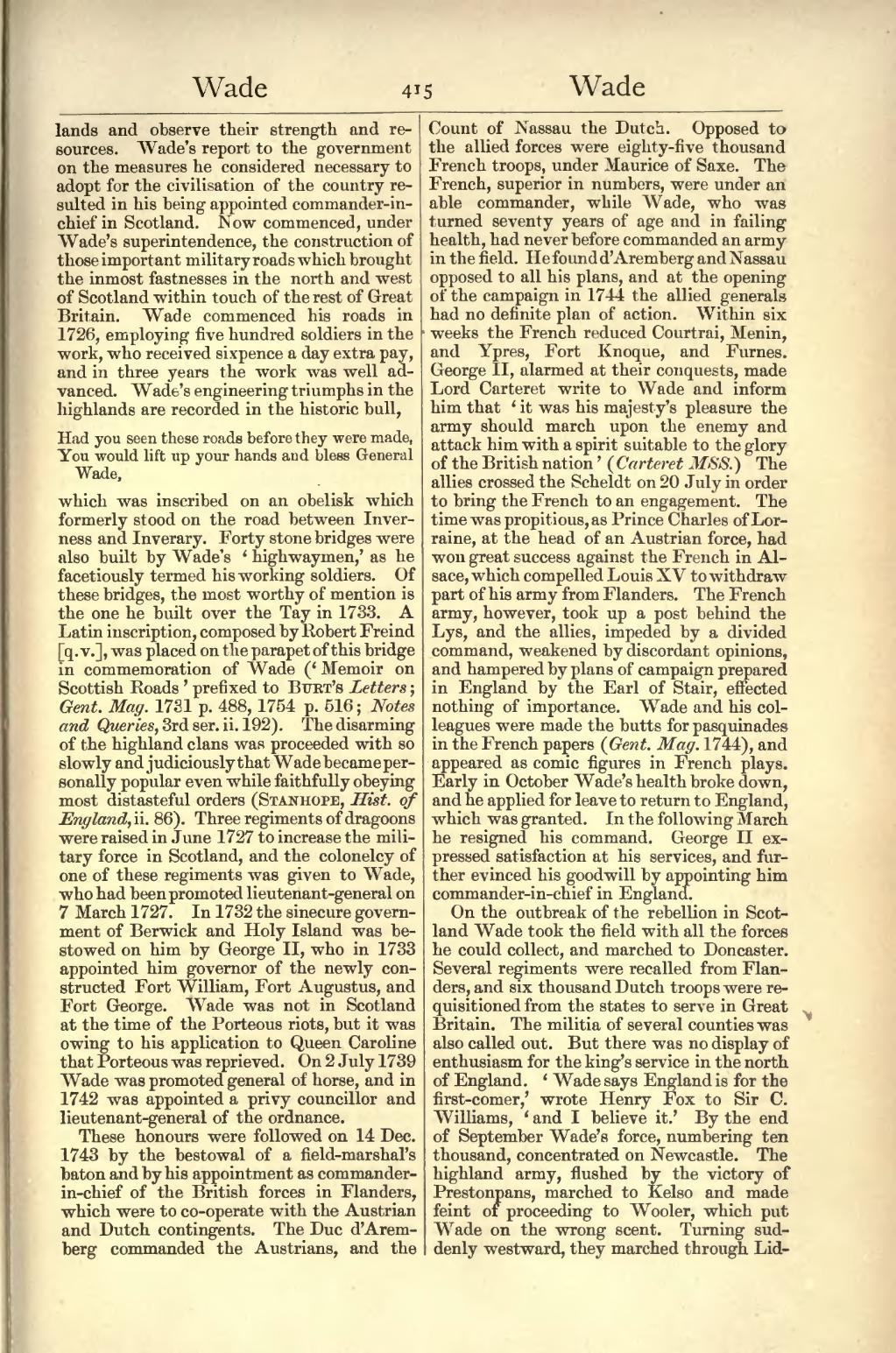lands and observe their strength and resources. Wade's report to the government on the measures he considered necessary to adopt for the civilisation of the country resulted in his being appointed commander-in-chief in Scotland. Now commenced, under Wade's superintendence, the construction of those important military roads which brought the inmost fastnesses in the north and west of Scotland within touch of the rest of Great Britain. Wade commenced his roads in 1726, employing five hundred soldiers in the work, who received sixpence a day extra pay, and in three years the work was well advanced. Wade's engineering triumphs in the highlands are recorded in the historic bull,
Had you seen these roads before they were made,
You would lift up your hands and bless General Wade,
which was inscribed on an obelisk which formerly stood on the road between Inverness and Inverary. Forty stone bridges were also built by Wade's ‘highwaymen,’ as he facetiously termed his working soldiers. Of these bridges, the most worthy of mention is the one he built over the Tay in 1733. A Latin inscription, composed by Robert Freind [q. v.], was placed on the parapet of this bridge in commemoration of Wade (‘Memoir on Scottish Roads’ prefixed to Burt's Letters; Gent. Mag. 1731 p. 488, 1754 p. 516; Notes and Queries, 3rd ser. ii. 192). The disarming of the highland clans was proceeded with so slowly and judiciously that Wade became personally popular even while faithfully obeying most distasteful orders (Stanhope, Hist. of England, ii. 86). Three regiments of dragoons were raised in June 1727 to increase the military force in Scotland, and the colonelcy of one of these regiments was given to Wade, who had been promoted lieutenant-general on 7 March 1727. In 1732 the sinecure government of Berwick and Holy Island was bestowed on him by George II, who in 1733 appointed him governor of the newly constructed Fort William, Fort Augustus, and Fort George. Wade was not in Scotland at the time of the Porteous riots, but it was owing to his application to Queen Caroline that Porteous was reprieved. On 2 July 1739 Wade was promoted general of horse, and in 1742 was appointed a privy councillor and lieutenant-general of the ordnance.
These honours were followed on 14 Dec. 1743 by the bestowal of a field-marshal's baton and by his appointment as commander-in-chief of the British forces in Flanders, which were to co-operate with the Austrian and Dutch contingents. The Duc d'Aremberg commanded the Austrians, and the Count of Nassau the Dutch. Opposed to the allied forces were eighty-five thousand French troops, under Maurice of Saxe. The French, superior in numbers, were under an able commander, while Wade, who was turned seventy years of age and in failing health, had never before commanded an army in the field. He found d'Aremberg and Nassau opposed to all his plans, and at the opening of the campaign in 1744 the allied generals had no definite plan of action. Within six weeks the French reduced Courtrai, Menin, and Ypres, Fort Knoque, and Furnes. George II, alarmed at their conquests, made Lord Carteret write to Wade and inform him that ‘it was his majesty's pleasure the army should march upon the enemy and attack him with a spirit suitable to the glory of the British nation’ (Carteret MSS.) The allies crossed the Scheldt on 20 July in order to bring the French to an engagement. The time was propitious, as Prince Charles of Lorraine, at the head of an Austrian force, had won great success against the French in Alsace, which compelled Louis XV to withdraw part of his army from Flanders. The French army, however, took up a post behind the Lys, and the allies, impeded by a divided command, weakened by discordant opinions, and hampered by plans of campaign prepared in England by the Earl of Stair, effected nothing of importance. Wade and his colleagues were made the butts for pasquinades in the French papers (Gent. Mag. 1744), and appeared as comic figures in French plays. Early in October Wade's health broke down, and he applied for leave to return to England, which was granted. In the following March he resigned his command. George II expressed satisfaction at his services, and further evinced his goodwill by appointing him commander-in-chief in England.
On the outbreak of the rebellion in Scotland Wade took the field with all the forces he could collect, and marched to Doncaster. Several regiments were recalled from Flanders, and six thousand Dutch troops were requisitioned from the states to serve in Great Britain. The militia of several counties was also called out. But there was no display of enthusiasm for the king's service in the north of England. ‘Wade says England is for the first-comer,’ wrote Henry Fox to Sir C. Williams, ‘and I believe it.’ By the end of September Wade's force, numbering ten thousand, concentrated on Newcastle. The highland army, flushed by the victory of Prestonpans, marched to Kelso and made feint of proceeding to Wooler, which put Wade on the wrong scent. Turning suddenly westward, they marched through Lid-
